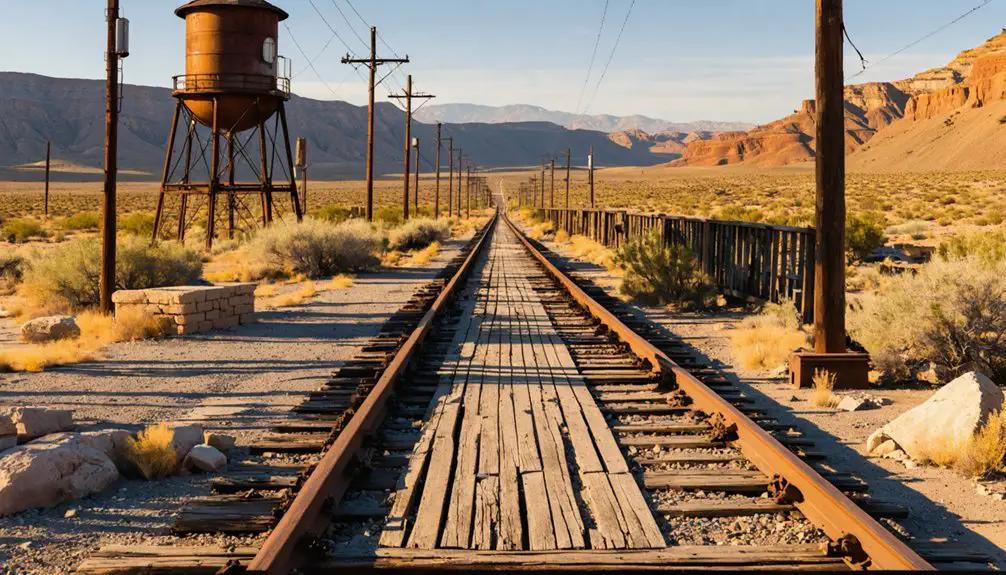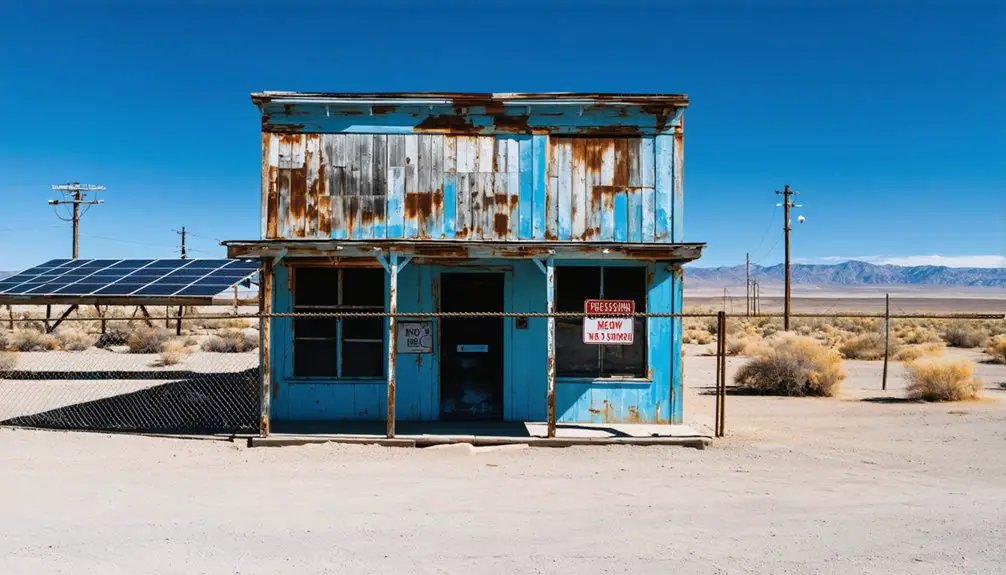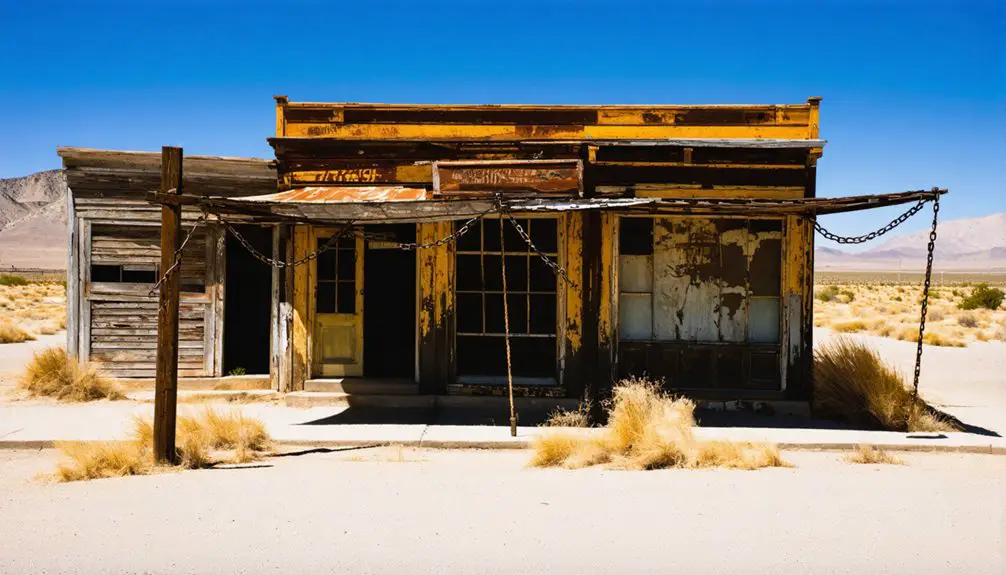You’ll find Palisade’s ghost town ruins in eastern Nevada, where this former railroad hub once thrived with 600 residents in the 1870s. The town gained fame for staging mock Wild West shootouts for passing train passengers, creating a profitable tourist attraction. After the devastating 1910 Humboldt River flood destroyed essential infrastructure, Palisade’s decline accelerated until its post office closed in 1962. The abandoned 160-acre site holds untold stories of frontier ingenuity and theatrical deception.
Key Takeaways
- Palisade began as a railroad town in 1868, growing into a significant transportation hub with a peak population of 600 residents.
- The town gained fame for staging elaborate Wild West performances for tourists, including mock gunfights and staged battles.
- A devastating flood in 1910 destroyed infrastructure, killed livestock, and marked the beginning of the town’s decline.
- The removal of railroad tracks in 1938 and closure of the post office in 1962 led to complete abandonment.
- The ghost town currently spans 160 acres of deteriorating historic structures with limited public access under anonymous ownership.
The Birth of a Railroad Town
When the Central Pacific Railroad established Palisade as a station along its Chicago-to-San Francisco line in 1868, they’d unknowingly set the stage for one of Nevada’s most strategic transportation hubs. Named after the towering cliffs reminiscent of the Hudson River’s formations, Palisade’s railroad origins quickly transformed it into a crucial nexus between eastern Nevada’s mining camps.
You’ll find the town’s emergence marked by the arrival of its post office in 1870, followed by the construction of machine shops and repair facilities. The town’s defenses included vertical wooden stakes surrounding key structures, following methods similar to those used in other frontier settlements. The arrival of the Eureka & Palisade Railroad in 1875 further cemented the town’s importance as a transportation center.
Mining prosperity soon followed as Palisade became the gateway for shipping ore from camps like Mineral Hill, Hamilton, and Eureka. By 1878, you could witness over 31 million pounds of bullion passing through this bustling junction, while its population swelled to 600 residents.
Wild West Theater: The Great Tourist Hoax
You’d find Palisade’s most profitable venture in its elaborate staged Wild West performances, where residents and Shoshone tribe members collaborated to create bloody gunfights, hangings, and mock invasions for unsuspecting train passengers.
Using cattle blood and blank ammunition, performers would time their violent spectacles to coincide with train arrivals, often sending terrified tourists scrambling for cover beneath the railway cars.
The orchestrated mayhem, complete with scripted Native American raids and resurrections of “hanged” victims at Johnson’s Saloon, established Palisade as one of America’s earliest Wild West entertainment ventures in the late 1870s. The town’s lucrative hoax performances lasted three profitable years, drawing thousands of visitors who spread tales of the untamed frontier. The performances began after the town fell into economic hardship when the mine became unprofitable, forcing residents to find creative ways to sustain their community.
Staged Violence For Profit
During the mid-1870s, Palisade’s residents orchestrated one of America’s most elaborate tourist hoaxes by staging Wild West violence for passing train passengers.
The calculated tourist deception featured mock gunfights, hangings, and bank robberies, complete with theatrical blood effects and blank ammunition. Local Native Americans, particularly Shoshone tribes, were hired to perform staged battles and “captive” displays on platforms.
This economic exploitation proved highly profitable as terrified tourists would stop to spend money in Palisade’s hotels, saloons, and stores.
The town’s strategic location along the Central Pacific Railroad and Eureka and Palisade Railroad made it an ideal spot for this frontier theater.
The performances grew increasingly sophisticated until railway decline and a devastating 1910 flood ended Palisade’s reign as America’s premier Wild West tourist trap. Despite its violent reputation, the town was so peaceful it operated without a local sheriff for many years.
Wild West Show Tactics
The citizens of Palisade crafted their infamous Wild West performances with calculated precision, responding to travelers’ disappointment with the town’s peaceful reality.
You’d find nearly every resident playing a role in these 10-minute theatrical spectacles, from saloon regulars to local women and children, creating an immersive historical experience that defied audience expectations.
The shows featured meticulously planned gunfights, bank robberies, and mock massacres, complete with butcher’s blood for authenticity. The performances always ended with the “victims” making miraculous recoveries at Johnson’s Saloon next door.
While the town lacked actual crime and didn’t even employ a sheriff, these performances transformed Palisade into a must-see tourist destination. Like the popular dime novels of the era, these shows perpetuated exaggerated myths of frontier life.
Journalists, unaware of the hoax, reported these staged incidents as fact, cementing Palisade’s reputation in Western mythology and pioneering the audience engagement techniques that would later influence Buffalo Bill’s famous touring shows.
Native American Performance Acts
While Palisade’s staged gunfights drew enthusiastic tourists, Native American performers brought a deeper layer of cultural complexity to Wild West shows. Performers collaborated with concert bands to enhance their traditional ceremonies and dances.
Through calculated audience manipulation, Indigenous performers turned stereotypical expectations into opportunities for cultural reclamation, preserving their traditions despite government suppression. The shows offered a vital escape from the devastating effects of Indian Boarding Schools, where Native children endured forced cultural assimilation and abuse.
You’ll find these key aspects of Native performances particularly fascinating:
- Authentic ceremonial dances and songs were cleverly woven into shows, allowing performers to practice banned rituals openly.
- War dances subtly conveyed narratives of Native strength and victory, contradicting intended portrayals of defeat.
- International tours provided performers economic independence and a global platform for cultural expression.
This strategic balance between meeting audience expectations and maintaining cultural sovereignty transformed Wild West shows into spaces of Indigenous resistance and preservation.
Life Behind the Staged Violence
While you’d expect a town known for its Wild West shootouts to be genuinely dangerous, Palisade’s real daily life was remarkably peaceful and orderly.
You’d find the roughly 600 residents going about their normal routines between performances, running businesses, working the railroad, and maintaining a stable community that didn’t even need a sheriff.
Behind the theatrical facade of gunfights and robberies, you’d see a prosperous service town where the staged violence was just another job, much like working at the general store or running the saloon.
Daily Town Reality
Behind Palisade’s theatrical facade of staged gunfights and mock violence lay a surprisingly tranquil community that went years without needing a sheriff.
The town’s actual daily rhythms revolved around peaceful community routines and basic town governance, far from the Wild West perception that visitors carried away.
While tourists witnessed carefully orchestrated mayhem, Palisade’s true character emerged through:
- A bustling transportation hub supporting nearby mining operations
- Local businesses, schools, and churches serving resident families
- Railroad jobs providing steady employment and economic stability
You’d find the real Palisade in its quiet moments between train arrivals – a hardworking community where staged violence was simply business theater, not daily reality.
The town’s authentic identity centered on commerce and community, not the gunslinging drama tourists briefly witnessed.
Behind the Show Business
Anyone watching Palisade’s staged violence in the 1870s wouldn’t have guessed that after the fake blood dried and blank cartridges were swept away, the town transformed into a peaceful community.
Behind the theatrical deception lay an intricate system of community collaboration, where residents, railroad workers, and local Shoshone tribe members coordinated their roles with precision.
You’d find townsfolk gathering at Johnson’s Saloon to plan elaborate backstories and choreograph the next day’s performances. The community crafted their illusions using cattle blood, blank ammunition, and carefully rehearsed scenarios.
While tourists witnessed what appeared to be lawless chaos, the truth revealed a town so safe it didn’t even need a sheriff. This creative enterprise united Palisade’s citizens in a shared secret that sustained their economy through the railroad boom years.
Railroad Glory Days

When the Central Pacific Railroad laid out Palisade in February 1870, they established what would become one of Nevada’s most significant rail hubs.
During the railroad expansion era, you’d have witnessed the town transform into a bustling center of commerce, reaching 600 residents at its peak. The town featured a large repair shop that serviced the trains and kept operations running smoothly.
The mining boom brought three major developments:
- Construction of the Eureka & Palisade Railroad in 1873, connecting silver-lead mines to the transcontinental route
- Transportation of over 31 million pounds of bullion in just five years
- Building of a grand new depot in 1882 to handle increased traffic
Natural Disaster and Economic Downturn
The catastrophic Humboldt River flood of 1910 marked Palisade’s dramatic reversal of fortune, destroying essential infrastructure and disrupting the town’s three major railroads. The flood impact paralyzed transportation when raging waters washed out over 30 miles of the Eureka and Palisade Railway and demolished 12 bridges along the Nevada Central Railroad.
You can trace Palisade’s rapid decline through the infrastructure collapse that followed. Fourteen passenger trains stalled near the town as floodwaters created temporary lakes spanning miles. The disaster killed 1,500 cattle and devastated local agriculture through damaged irrigation systems.
As rail companies struggled to recover, jobs vanished. Peak flows of 17,000 cubic feet per second overwhelmed the region’s defenses, ultimately triggering Palisade’s transformation into a ghost town by the mid-20th century.
The Path to Abandonment

Despite its strategic railroad origins in 1868, Palisade’s path to abandonment began with subtle signs of decline in 1885 as mining activity waned and commercial train traffic diminished.
The community’s economic challenges accelerated dramatically after the devastating 1910 flood, leading to an irreversible community decline.
You’ll find three key markers that sealed Palisade’s fate:
- The 1938 removal of Eureka-Nevada Railroad rails, eliminating essential transportation links
- Population plummeting from 242 in 1915 to under 150 within just a few years
- The 1962 closure of the post office, marking the town’s official abandonment
Legacy of the Ghost Town
Beneath Palisade’s crumbling ruins lies a complex legacy that transformed America’s understanding of the Wild West.
Today, you’ll find only remnants of buildings and a lonely cemetery marking this once-bustling frontier town, yet its cultural memory endures far beyond its physical remains.
As one of the earliest forms of immersive entertainment, Palisade’s theatrical hoaxes blurred reality with spectacle, staging gunfights and mock Indian raids for unsuspecting train passengers.
This ghost town’s resilience in American folklore stems from both its genuine economic importance – processing over 31 million pounds of bullion by 1878 – and its reputation as “the roughest town west of Chicago.”
The town’s mix of authentic frontier hardships and carefully crafted performances continues to challenge historians’ interpretation of Western expansion, making Palisade a unique lens through which to view American frontier mythology.
Modern Ownership and Preservation

Since its final post office closure in 1961, Palisade’s ownership has shifted through notable changes, including decades under John Sexton’s family stewardship until a pivotal 2005 auction in San Francisco.
The town’s current ownership remains anonymous following its $150,000 sale, creating uncertainty about its preservation trajectory.
You’ll find Palisade faces significant preservation challenges across its 160-acre expanse:
- Natural deterioration from floods and abandonment threatens historic structures
- Limited public access due to private ownership status complicates conservation efforts
- Absence of formal preservation programs leaves historical artifacts vulnerable
While the ghost town’s rich heritage as a railroad hub and staged Wild West attraction enhances its cultural value, its future hangs in balance between private property rights and historical conservation interests.
Frequently Asked Questions
Can Visitors Access the Ghost Town Site Today?
You’ll find unrestricted access to the site today without formal regulations. For best exploration of ruins and cemetery, bring water and sturdy shoes while respecting any private property boundaries.
What Remains of the Original Buildings and Structures?
You’ll find minimal historical preservation: one occupied home, a deteriorating wooden cabin, scattered building foundations, damaged dugouts, and an intact cemetery remain as the last architectural features today.
Were Any Movies or Documentaries Filmed in Palisade?
Like a forgotten stage without its actors, you won’t find any documented films or documentaries shot in Palisade, though ironically the town’s earlier staged gunfights and hoaxes were theatrical performances themselves.
Are There Guided Tours Available of the Historic Town Site?
You won’t find official guided tours, but you’re free to explore the site independently. The historical significance remains through building remnants and cemetery, though you’ll need to plan your own guided exploration.
Have There Been Any Paranormal Activities Reported in Palisade?
You’ll find few credible haunted stories at this site – while local legends mention ghost sightings near an obscure building and a mysterious suitcase discovery, there’s no solid evidence of paranormal activity.
References
- https://en.wikipedia.org/wiki/Palisade
- https://www.rainesmarket.com/palisade.html
- https://theinternetsaysitstrue.com/2024/09/08/palisade-nevada/
- https://www.messynessychic.com/2021/10/05/once-upon-a-time-in-the-real-westworld-hoax-town/
- https://nvtami.com/2024/10/23/palisade-the-roughest-toughest-town-west-of-chicago/
- https://www.atlasobscura.com/places/palisade-nevada
- https://www.nvexpeditions.com/eureka/palisade.php
- https://www.ranker.com/list/palisade-nevada-history/melissa-sartore
- https://acunit.home.blog/2022/09/28/palisade-nevada/
- https://www.youtube.com/watch?v=ATYBf9Q8Ly8



